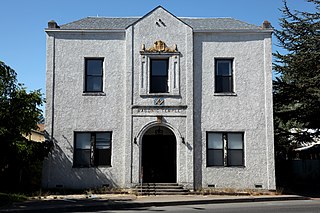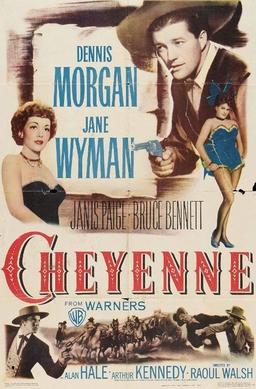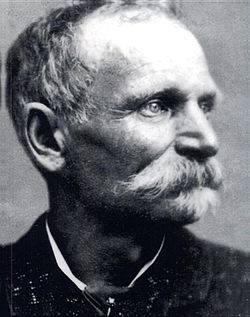
"Riding shotgun" was a phrase used to describe the bodyguard who rides alongside a stagecoach driver, typically armed with a break-action shotgun, called a coach gun, to ward off bandits or hostile Native Americans. In modern use, it refers to the practice of sitting alongside the driver in a moving vehicle. The coining of this phrase dates to 1905 at the latest.

Willits is a city in Mendocino County, California, United States. It is located about 20 miles (32 km) north-northwest of Ukiah, at an elevation of 1,391 feet (424 m). The population was 4,988 at the 2020 census. Willits is at the center of Mendocino County and at the beginning of the county's extensive redwood forests as approached by Highway 101 from the south.

Yreka is the county seat of Siskiyou County, California, United States, near the Shasta River; the city has an area of about 10 square miles (26 km2), most of it land. As of the 2020 United States Census, the population was 7,807, reflecting a meager increase from 7,765 counted in the 2010 Census. Yreka is home to the College of the Siskiyous, Klamath National Forest Interpretive Museum and the Siskiyou County Museum.

The Gold Country is a historic region in the northern portion of the U.S. state of California, that is primarily on the western slope of the Sierra Nevada. It is famed for the mineral deposits and gold mines that attracted waves of immigrants, known as the 49ers, during the 1849 California Gold Rush.
Tom Bell was a western outlaw and physician known as the "Outlaw Doc". He was the first outlaw to organize a stagecoach robbery in the United States.

The Siskiyou Trail stretched from California's Central Valley to Oregon's Willamette Valley; modern-day Interstate 5 follows this pioneer path. Originally based on existing Native American foot trails winding their way through river valleys, the Siskiyou Trail provided the shortest practical travel path between early settlements in California and Oregon.

Buck English was an American Old West outlaw, and one of Lake County, California's most notorious thieves and stagecoach robbers toward the end of the 19th century.

James B. Hume was one of the American West's premier lawmen.

Black Bart is a 1948 American Western Technicolor film directed by George Sherman and starring Yvonne De Carlo, and Dan Duryea as the real-life stagecoach bandit Charles E. Boles, known as Black Bart. The movie was produced by Leonard Goldstein with a screenplay written by Luci Ward, Jack Natteford and William Bowers. The film, also known under the alternate title Black Bart, Highwayman, was released by Universal Pictures on March 3, 1948.

Area code 530 is a telephone area code in the North American Numbering Plan (NANP) in northeastern and Northern California. It was created in 1997 in an area code split of 916.

Richard H. Barter, known as "Rattlesnake Dick", was born in Lower Canada. Around 1850, he came to California on the Oregon Trail with three other family members. He tried his luck at mining at Rattlesnake Bar during the California Gold Rush. He was twice charged, and once convicted, of being a thief, the second time for stealing a mule. Once the mule and the real thief were found, he was released.
Henry Nicholson Morse, "bloodhound of the far west," was an Old West lawman. Elected September 2, 1863 served from 1864 to 1878, as the sheriff of the Alameda County Sheriff's Office of Alameda County, California. He was a Republican. He later founded the Harry N. Morse Detective Agency in California. One of his accomplishments was to help identify Charles E. Boles as the perpetrator of the Black Bart stagecoach robberies. Other notable early California outlaws he helped bring to justice include Bartolo Sepulveda, Narrato Ponce, "Red-Handed Procopio, and Juan Soto.

Cheyenne is a 1947 American western mystery film directed by Raoul Walsh and starring Dennis Morgan, Jane Wyman, Janis Paige and Bruce Bennett. It was produced and released by Hollywood major Warner Bros.
The Lynching of the Ruggles brothers took place on July 24, 1892 in Redding, California.

Gillett, Arizona, is a ghost town in Yavapai County, Arizona, United States. It has an estimated elevation of 1,362 feet (415 m) above sea level. Historically, it was a stagecoach station, and then a settlement formed around an ore mill serving the Tip Top Mine, on the Agua Fria River in Yavapai County in what was then Arizona Territory. It was named for the mining developer of the Tip Top Mine, Dan B. Gillett and is spelled incorrectly as Gillette on U. S. Topographic Maps and elsewhere.
Harry Head, was a cattle rustler and stagecoach robber. One of his better known robberies occurred outside Contention City, a boomtown in the Arizona Territory.
Ridgewood Summit is a low mountain pass in Mendocino County, California, traversed by U.S. Route 101 at an altitude of 1,956 feet (596 m). It crosses the Mendocino Range, connecting Ukiah and the watershed of the Russian River, on the south of the pass, to Willits and the watershed of the Eel River on the north. It is the highest pass on U.S. Route 101 in California. Greenough Ridge and Irene Peak rise to the west of the pass. The spur of the Mendocino Range to the east of the pass is called the Laughlin Range.
Marysville Cemetery also known as Historic Marysville City Cemetery, is a no longer active city-owned cemetery that was established in 1850, and is located in Marysville, California. Historically this cemetery has been prone to flooding.

Bass Hill is a historical site in Redding, California in Shasta County. Bass Hill site is a California Historical Landmark No. 148 listed on January 11, 1935. On the top of Bass Hill the California and Oregon Stagecoach crossed the Pacific Highway and then dropped to the Pit River. The road, Old California-Oregon Road, on Bass Hill was popular bandit holdup spot. A historical Marker is on Bass Hill to Willianson Lyncoya Smith, division stage agent of the California and Oregon Stage Company and other drivers. Smith was pioneer stagecoach driver on the Bass Hill road. The Oregon Stage Line owned the California-Oregon Stagecoach Company for some years. The California and Oregon Coast Overland Mail, operated the California-Oregon Stagecoach Company Line. The California-Oregon Stagecoach Company had daily stage service with both mail and passengers. The California-Oregon Stagecoach Company also operated in the winter months with sleighs over Scott Mountains. California-Oregon Stagecoach Company had a line from Portland and Sacramento by 1860. In 1870, the California-Oregon Stagecoach Company changed its route, the new line ran from Shasta-Yreka Road through French Gulch to the Sacramento River Canyon route and bypassed Shasta. The California-Oregon Stagecoach Company ran operated until rail service replaced its routes in 1887.

Old California Oregon Road is a historical site in Anderson, California, in Shasta County. Old California Oregon Road site is California Historical Landmark No. 58 listed on December 6, 1932. The Old California Oregon Road was the main road used by pioneer travelers between the Trinity River and the northern gold mines of California and Oregon. The main part of the Old California Oregon Road ran from Portland to Sacramento.













